Potřebujeme váš souhlas k využití jednotlivých dat, aby se vám mimo jiné mohly ukazovat informace týkající se vašich zájmů. Souhlas udělíte kliknutím na tlačítko „OK“.
ASTM D6822-12b
Standard Test Method for Density, Relative Density, and API Gravity of Crude Petroleum and Liquid Petroleum Products by Thermohydrometer Method (Includes all amendments And changes 7/31/2017).
Automaticky přeložený název:
Standardní zkušební metoda pro hustoty, relativní hustoty a měrné hmotnosti API ropy a kapalných ropných produktů Thermohydrometer metodou
NORMA vydána dne 1.6.2012
Informace o normě:
Označení normy: ASTM D6822-12b
Poznámka: NEPLATNÁ
Datum vydání normy: 1.6.2012
Kód zboží: NS-36668
Počet stran: 10
Přibližná hmotnost: 30 g (0.07 liber)
Země: Americká technická norma
Kategorie: Technické normy ASTM
Kategorie - podobné normy:
Anotace textu normy ASTM D6822-12b :
Keywords:
API gravity, density, hydrometer, hydrometer cylinder, relative density, thermohydrometer, thermometer, ICS Number Code 75.040 (Crude petroleum), 75.080 (Petroleum products in general)
Doplňující informace
| Significance and Use | ||||||||||||||
|
Density and API gravity are used in custody transfer quantity calculations and to satisfy transportation, storage, and regulatory requirements. Accurate determination of density or API gravity of crude petroleum and liquid petroleum products is necessary for the conversion of measured volumes to volumes at the standard temperatures of 15°C or 60°F. Density and API gravity are also factors that indicate the quality of crude petroleum. Crude petroleum prices are frequently posted against values in kg/m3 or in degrees API. However, this property of petroleum is an uncertain indication of its quality unless correlated with other properties. Field of Application—Because the thermohydrometer incorporates both the hydrometer and thermometer in one device, it is more applicable in field operations for determining density or API gravity of crude petroleum and other liquid petroleum products. The procedure is convenient for gathering main trunk pipelines and other field applications where limited laboratory facilities are available. The thermohydrometer method may have limitations in some petroleum density determinations. When this is the case, other methods such as Test Method (API MPMS Chapter 9.1) may be used. This procedure is suitable for determining the density, relative density, or API gravity of low viscosity, transparent or opaque liquids, or both. This procedure, when used for opaque liquids, requires the use of a meniscus correction (see 9.2). Additionally for both transparent and opaque fluids the readings shall be corrected for the thermal glass expansion effect and alternate calibration temperature effects before correcting to the reference temperature. This procedure can also be used for viscous liquids by allowing sufficient time for the thermohydrometer to reach temperature equilibrium. |
||||||||||||||
| 1. Scope | ||||||||||||||
|
1.1 This test method covers the determination, using a glass thermohydrometer in conjunction with a series of calculations, of the density, relative density, or API gravity of crude petroleum, petroleum products, or mixtures of petroleum and nonpetroleum products normally handled as liquids and having a Reid vapor pressures of 101.325 kPa (14.696 psi) or less. Values are determined at existing temperatures and corrected to 15°C or 60°F by means of a series of calculations and international standard tables. 1.2 The initial thermohydrometer readings obtained are uncorrected hydrometer readings and not density measurements. Readings are measured on a thermohydrometer at either the reference temperature or at another convenient temperature, and readings are corrected for the meniscus effect, the thermal glass expansion effect, alternate calibration temperature effects and to the reference temperature by means of calculations and Adjunct to D1250 Guide for Use of the Petroleum Measurement Tables (API MPMS Chapter 11.1). 1.3 Readings determined as density, relative density, or API gravity can be converted to equivalent values in the other units or alternate reference temperatures by means of Interconversion Procedures (API MPMS Chapter 11.5) or Adjunct to D1250 Guide for Use of the Petroleum Measurement Tables (API MPMS Chapter 11.1), or both, or tables as applicable. 1.4 The initial thermohydrometer reading shall be recorded before performing any calculations. The calculations required in Section 9 shall be applied to the initial thermohydrometer reading with observations and results reported as required by Section 11 prior to use in a subsequent calculation procedure (measurement ticket calculation, meter factor calculation, or base prover volume determination). 1.5 Annex A1 contains a procedure for verifying or certifying the equipment of this test method. 1.6 The values stated in SI units are to be regarded as standard. The values given in parentheses are for information only. 1.7 This standard does not purport to address all of the safety concerns, if any, associated with its use. It is the responsibility of the user of this standard to establish appropriate safety and health practices and determine the applicability of regulatory limitations prior to use. |
||||||||||||||
| 2. Referenced Documents | ||||||||||||||
|
Podobné normy:
Historická
1.10.2013
Historická
1.12.2012
Historická
1.6.2011
Historická
1.5.2011
Historická
1.10.2010
Historická
1.10.2013
Odebírejte informace o nově vydaných normách ZDARMA:
Chcete pravidelně odebírat informace o nově vycházejících normách z celého světa a to zcela zdarma?
Přihlašte se k odběru. Vše je velice jednoduché a absolutně ZDARMA.
Na výběr máte vydavatele z celého světa.


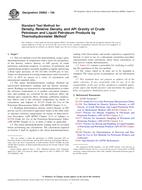
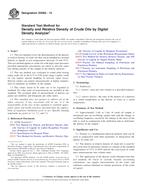 ASTM D5002-13
ASTM D5002-13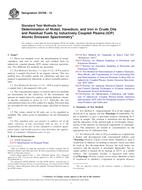 ASTM D5708-12
ASTM D5708-12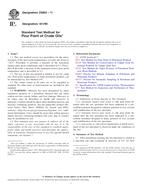 ASTM D5853-11
ASTM D5853-11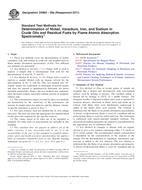 ASTM D5863-00a(2011)..
ASTM D5863-00a(2011)..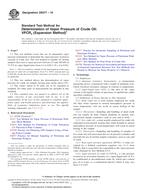 ASTM D6377-10
ASTM D6377-10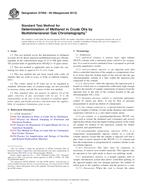 ASTM D7059-09(2013)..
ASTM D7059-09(2013)..
 Cookies
Cookies
